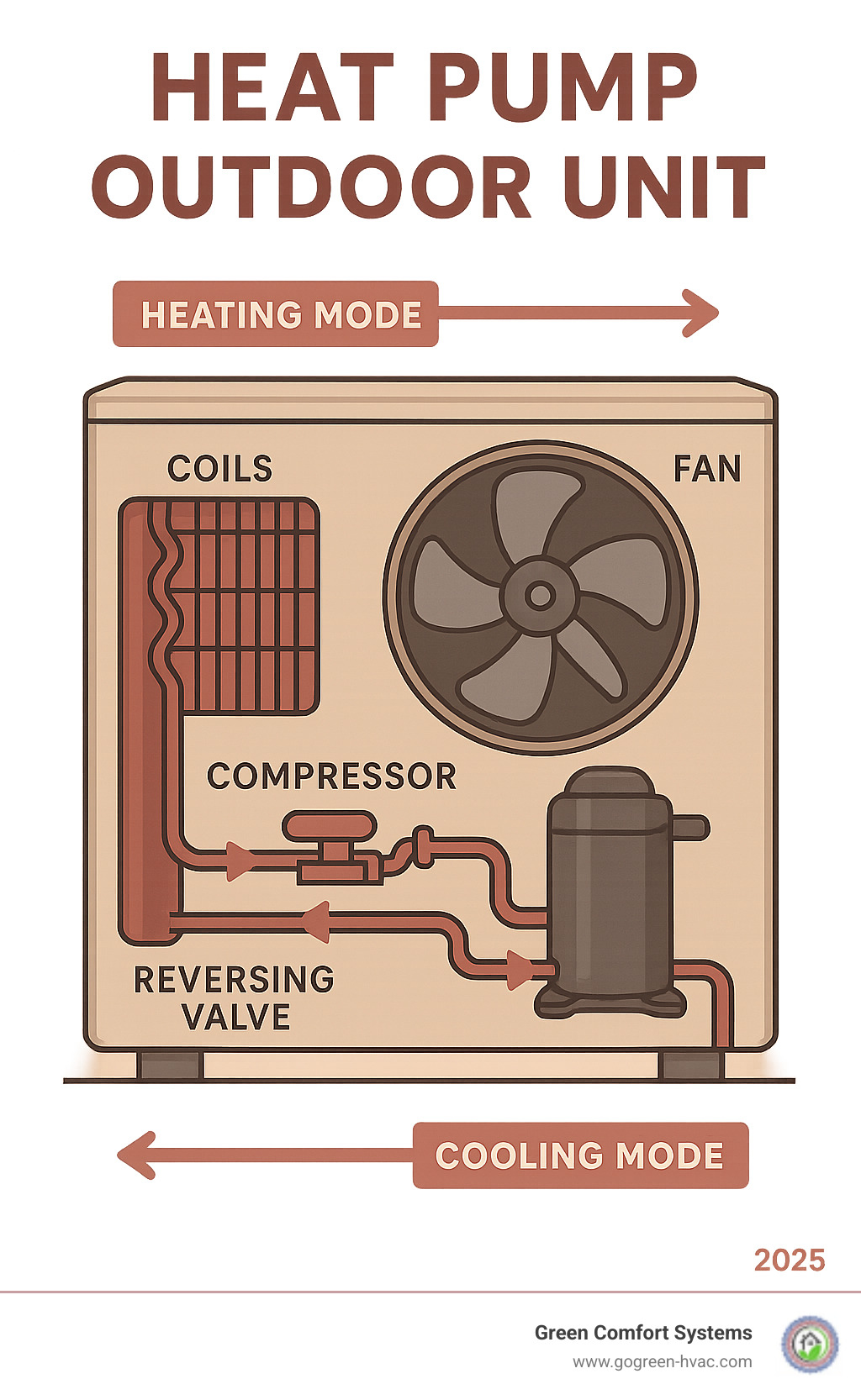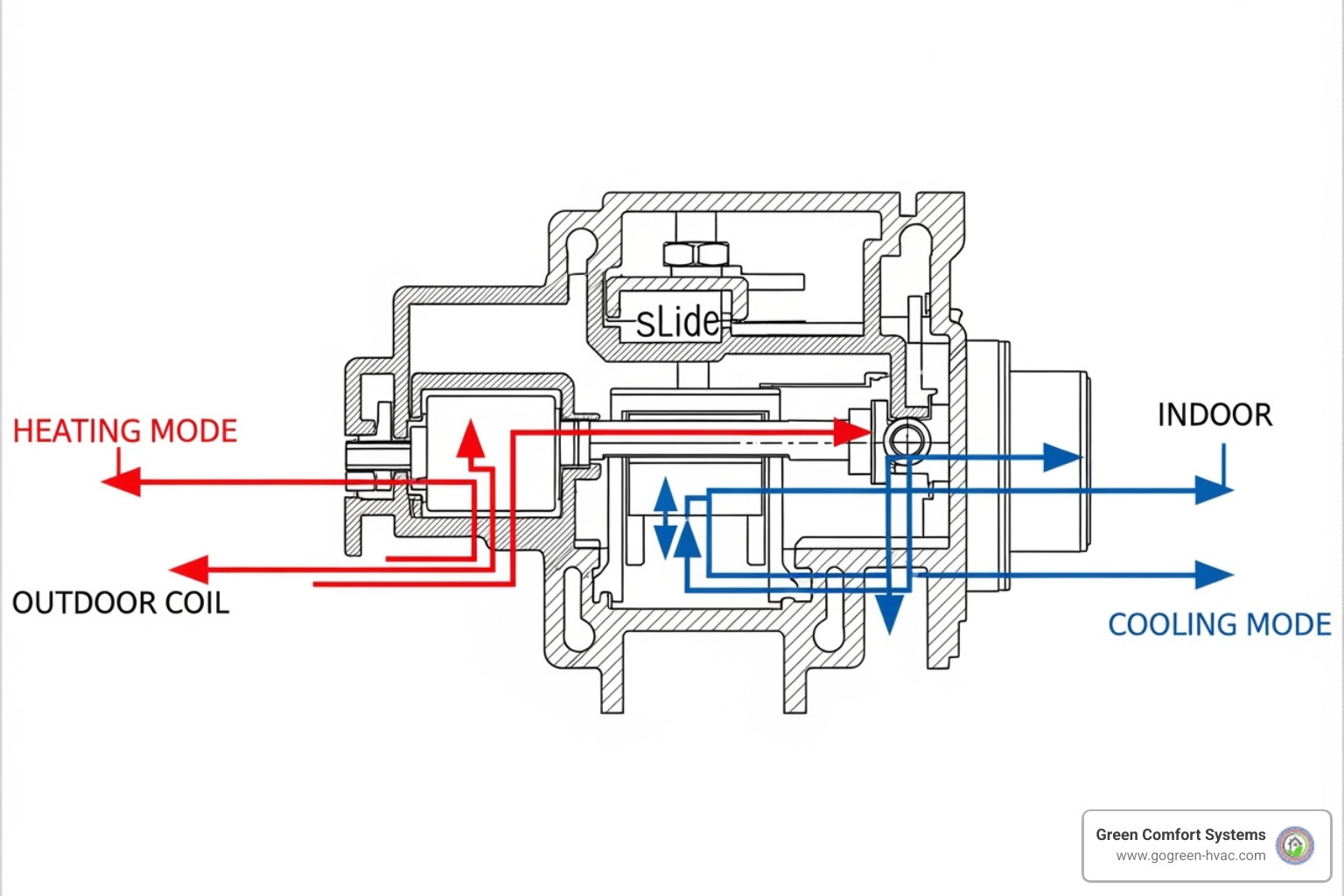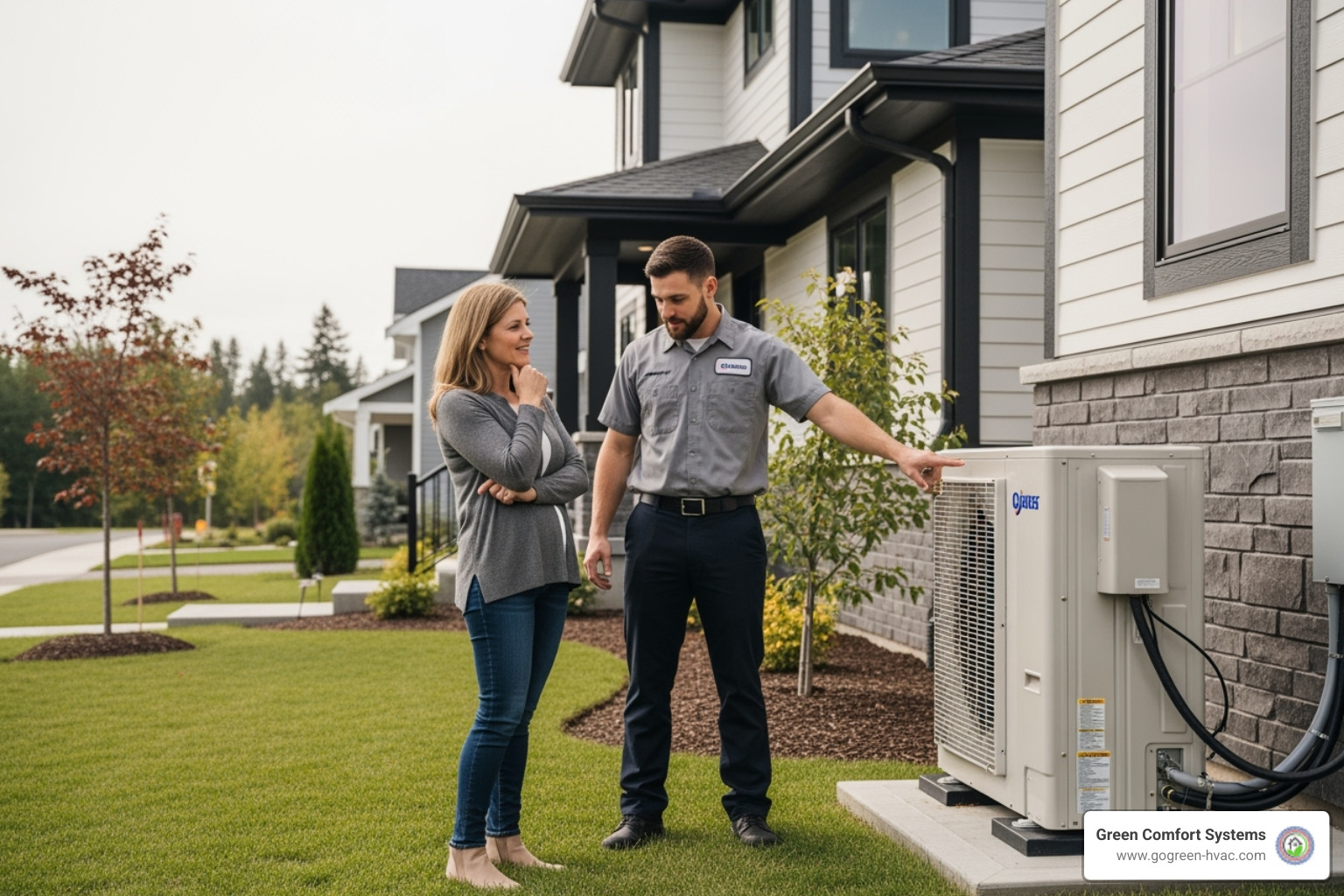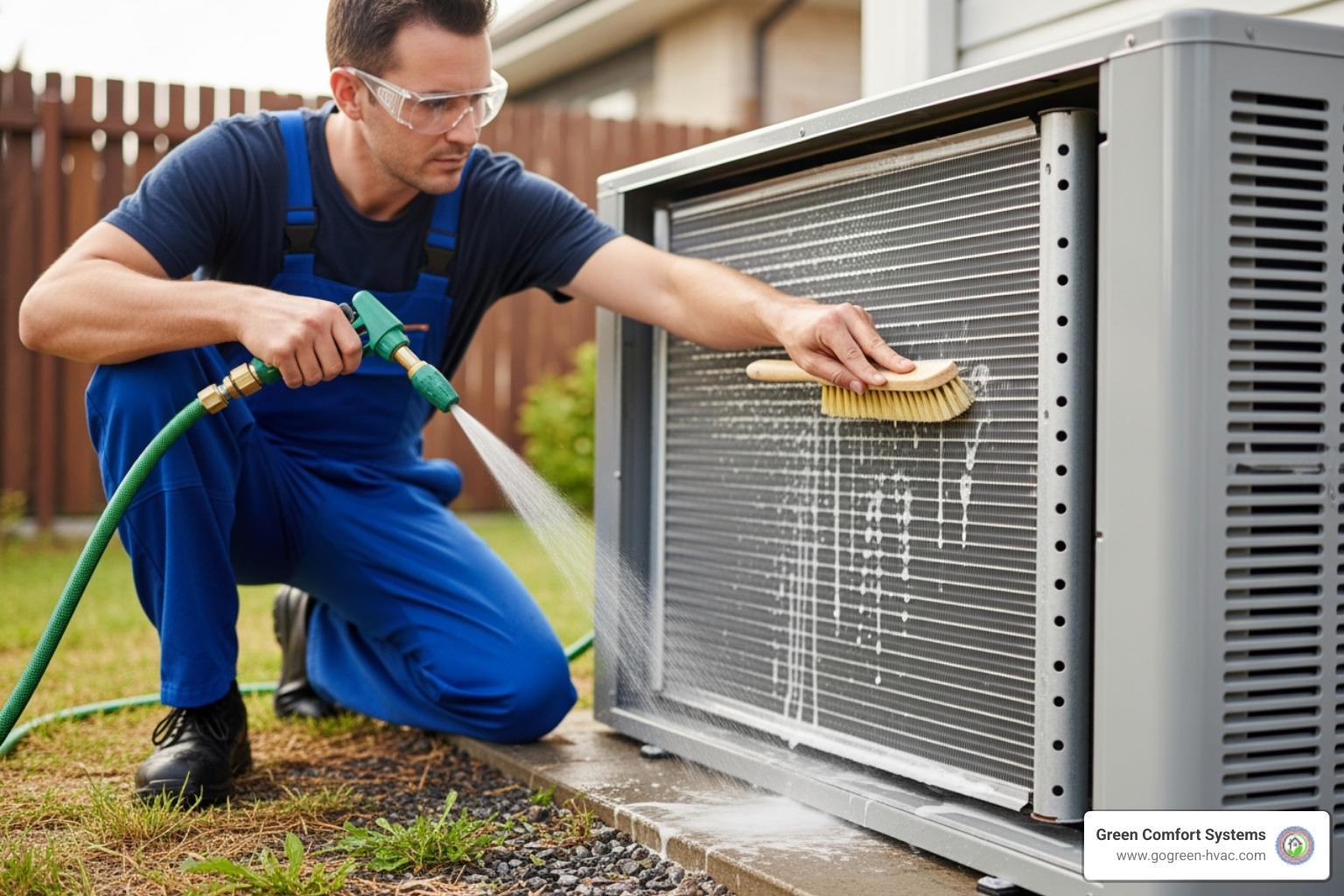Beyond the Box: What Your Heat Pump's Outdoor Unit Really Does

The Unsung Hero of Your Home's Climate
A heat pump outdoor unit is the essential component that makes year-round climate control possible by transferring heat between your home and the outside air. This powerful system can both heat and cool your home using the same equipment, making it one of the most versatile HVAC solutions available.
Key functions of your heat pump outdoor unit:
- Heating Mode: Extracts heat from outside air (even in cold weather) and moves it indoors
- Cooling Mode: Removes heat from inside your home and releases it outdoors
- Energy Efficiency: Uses electricity to move heat rather than generate it, reducing energy costs
- Year-Round Operation: Switches seamlessly between heating and cooling as needed
- Environmentally Friendly: Reduces carbon footprint compared to traditional heating systems
The outdoor unit works by circulating refrigerant through coils and using a compressor to pressurize the system. A reversing valve changes the direction of refrigerant flow to switch between heating and cooling modes.
For homeowners in Rosedale dealing with HVAC system failures or looking for reliable climate solutions, understanding how your heat pump's outdoor unit works can help you make better maintenance decisions and spot potential issues early.

The Heart of Your Home's Comfort: The Heat Pump Outdoor Unit
Think of your heat pump outdoor unit as the hardworking friend who never gets enough credit. While you're inside enjoying perfect temperatures, this remarkable piece of equipment is outside doing all the heavy lifting – literally moving heat around to keep you comfortable year-round.
Unlike a furnace that burns fuel to create heat, your heat pump is more like a heat detective, finding warmth where you might not expect it and moving it exactly where you need it. Even on a chilly winter day when the air feels bone-cold to you, your heat pump outdoor unit can still extract heat from that same air and bring it inside to warm your home.
How Your Heat Pump Outdoor Unit Works Year-Round
The magic happens through something called the refrigeration cycle – think of it as your heat pump's daily workout routine that never stops. This process uses a special fluid called refrigerant that acts like a thermal courier, picking up heat in one location and delivering it to another.
Here's where it gets really clever: your heat pump outdoor unit can completely reverse this process depending on what your home needs. During summer, it grabs the heat from inside your house and tosses it outside. Come winter, it flips the script and pulls heat from the outdoor air to warm your home.
The star of this show is something called a reversing valve. This ingenious component changes the direction that refrigerant flows through the system, essentially telling your heat pump whether to heat or cool your home.

In cooling mode, your indoor coil becomes the heat absorption center, soaking up warmth from your home's air. The refrigerant carries this heat outside, where your heat pump outdoor unit releases it into the atmosphere through heat release. It's like your home is exhaling all its excess warmth through the outdoor unit.
In heating mode, the process flips completely. Now your heat pump outdoor unit becomes the heat collector, absorbing thermal energy from outside air (yes, even when it's freezing!). The refrigerant brings this captured heat indoors, where it's released to warm your living space.
This is why heat pumps are so efficient – they're not creating heat from scratch, they're just moving it around. For homeowners in Maryland's varied climate, this means reliable comfort whether you're dealing with sweltering summers or chilly winters. You can learn more about ENERGY STAR Cold Climate heat pumps to see how these systems perform even in harsh conditions.
Inside the Box: Key Components of a Heat Pump Outdoor Unit
Your heat pump outdoor unit might look like a simple metal box, but inside it's packed with sophisticated components working together like a well-orchestrated team.
The compressor is truly the heart of the operation. This powerful component pressurizes the refrigerant, dramatically increasing its temperature so it can effectively release or absorb heat. Modern units often feature inverter technology, which lets the compressor adjust its speed to match your home's exact needs – kind of like cruise control for your comfort system.
Working alongside the compressor are the condenser coil and evaporator coil. These finned coils look similar to a car radiator and are where the actual heat transfer magic happens. Depending on whether you're heating or cooling, these coils switch roles – one absorbing heat while the other releases it.
The fan and motor might seem simple, but they're crucial for moving air across those coils. Without proper airflow, even the best heat pump can't do its job effectively. The fan ensures heat moves efficiently between the refrigerant and the outdoor air.
Connecting everything together are the refrigerant lines – insulated copper tubes that create a closed loop between your indoor and outdoor units. These lines are like the circulatory system, allowing refrigerant to flow back and forth, carrying heat with it.
Here's a quick breakdown of the main players:
- Compressor: The "heart" of the system, pressurizing refrigerant to move heat
- Coils: Absorb and release heat between the refrigerant and the outside air
- Fan: Moves air across the coils to facilitate heat exchange
- Reversing Valve: Changes the direction of refrigerant flow to switch between heating and cooling
Choosing the Right Unit for Your Home
Picking the perfect heat pump outdoor unit is a bit like finding the right pair of shoes – it needs to fit your specific situation perfectly. Too small, and you'll be uncomfortable. Too big, and you'll waste money while still not getting the performance you want.

Sizing is absolutely critical and measured in BTUs (British Thermal Units). This isn't something you can eyeball or guess at. Your home's size, insulation quality, window types, and even how many people live there all factor into the equation. Get it wrong, and your system will either struggle to keep up or cycle on and off constantly, wasting energy and wearing out faster.
Efficiency ratings tell you how much comfort you'll get for every dollar spent on electricity. SEER2 ratings measure cooling efficiency – higher numbers mean lower summer electric bills. HSPF2 ratings do the same for heating performance. These ratings directly translate to your long-term operating costs.
Climate suitability matters more than you might think. While heat pumps work great in Maryland's mixed climate, choosing a unit designed for both hot summers and cold winters ensures year-round reliability. Some models are specifically engineered for cold climates and can extract heat efficiently even when temperatures drop well below freezing.
Don't forget about noise levels. Your heat pump outdoor unit will run regularly, so if it's near a patio or bedroom window, you'll want a quieter model. Modern units with inverter technology tend to run much more quietly than older systems.
We always recommend starting your search with ENERGY STAR® certified heat pumps. These units meet strict efficiency standards, ensuring you get reliable performance while keeping energy costs in check.
Is a Heat Pump Right for You? Installation, Costs, and Benefits
Making the leap to a heat pump is more than just upgrading your HVAC system—it's investing in your home's future comfort, efficiency, and environmental impact. Now that you understand how your heat pump outdoor unit works its magic, let's talk about what it really means to bring this technology into your home.
Installation and Maintenance Essentials
Think of installing a heat pump like planting a tree (which we actually do for every installation!). The care you put into choosing the right spot and nurturing it from the start determines how well it will serve you for years to come.
Proper placement is absolutely critical for your heat pump outdoor unit. This isn't just about finding any available space in your yard. The unit needs room to breathe—literally. When we scout your property, we're looking for a spot with plenty of clearance requirements around all sides. Your heat pump's fan needs to pull in fresh air and expel heated or cooled air without fighting against walls, fences, or overgrown shrubs.
We always install your unit on a level concrete pad. This might seem like a small detail, but it's huge for your system's longevity. A solid, level foundation prevents your unit from settling unevenly, which can throw internal components out of alignment and create unnecessary vibration and noise. Plus, it helps water drain away properly instead of pooling around your equipment.

Regular cleaning is something you can do yourself to keep your system happy. Your heat pump outdoor unit sits outside year-round, collecting leaves, grass clippings, and whatever else Maryland weather throws at it. A gentle rinse with your garden hose (with the power turned off, of course!) can work wonders for keeping those coils clear and your system running efficiently.
But here's where we come in with professional tune-ups. Just like you wouldn't skip your car's oil changes, your heat pump needs expert attention twice a year. We check refrigerant levels, clean coils thoroughly, inspect electrical connections, and catch small issues before they become expensive problems. It's amazing how much longer systems last when they get this kind of care.
Don't forget about filter changes either. That filter in your indoor unit might seem separate from your outdoor equipment, but a dirty filter makes your entire system work harder. We recommend checking it monthly—your heat pump outdoor unit will thank you with better performance and lower energy bills.
Professional installation follows detailed specifications to ensure everything works perfectly together. For reference, installations follow strict guidelines similar to those found in a Mini VRF installation manual, ensuring every component is properly integrated.
Performance, Costs, and Financial Incentives
Let's be honest about what you can expect from your heat pump investment, because understanding the real-world performance helps you make the best decision for your home.
Cold climate performance has come a long way. Modern heat pumps, especially those designed for our Maryland winters, can extract heat from outdoor air even when it's well below freezing. We're talking about effective heating down to 0°F or even colder. It might seem impossible, but remember—even cold air contains heat energy that your system can capture and move indoors.
When temperatures drop to extreme lows, supplemental heat kicks in automatically. Most systems include electric resistance coils as backup, or we can set you up with a dual-fuel system that uses your existing gas furnace for those rare arctic blasts. You'll never be left in the cold.
Hot climate performance is where heat pumps really shine. Maryland summers can be brutal, but your system moves that indoor heat outside efficiently while providing excellent dehumidification. That moisture removal is a game-changer for comfort—you'll feel cooler at higher temperatures, which means you can set your thermostat a bit higher and save even more energy.
Now, let's talk money. Upfront costs vs. long-term savings is probably your biggest question. Yes, a quality heat pump system might cost more initially than a basic furnace or air conditioner. But here's the thing—heat pumps move heat instead of creating it, making them incredibly efficient. For every dollar you spend on electricity, you get two to four dollars' worth of heating or cooling. That efficiency translates directly to lower monthly bills.
Federal tax credits can significantly reduce your initial investment. Thanks to recent legislation, you can claim 30% of your installation costs as a tax credit, up to $2,000. That's real money back in your pocket for choosing an efficient, environmentally responsible system.
Your savings don't stop there. Many states and local utilities offer additional incentives. We encourage you to check for state-administered HP rebates to see what's available in your area. Our team stays current on all available programs and can help you steer the paperwork to maximize your savings.
Your Partner in Sustainable Comfort
Choosing Green Comfort Systems means choosing a partner who cares about your comfort and our shared environment. When you invest in a heat pump, you're making a statement about the kind of future you want for your family and community.
The environmental benefits are substantial. By moving heat instead of burning fossil fuels, your heat pump outdoor unit dramatically reduces your home's carbon footprint. Every month you operate your system, you're contributing to cleaner air and a healthier planet. It's a choice that feels good on multiple levels.
This reduced carbon footprint becomes even more impressive over time. If you're currently heating with oil, propane, or natural gas, switching to an electric heat pump can cut your heating-related emissions by 50% or more. As our electrical grid incorporates more renewable energy, your environmental impact gets even smaller.
Increased home value is an often-overlooked benefit. Today's homebuyers are smart—they're looking for energy-efficient features that translate to lower operating costs. A modern, professionally installed heat pump system is a significant selling point that can set your home apart in the market.
Expert consultation is what sets us apart from the competition. HVAC systems aren't one-size-fits-all, and we take the time to understand your home's unique needs. From proper sizing calculations to selecting the right efficiency ratings for your usage patterns, we handle every detail with care.
At Green Comfort Systems, we're not just your local HVAC experts serving Rosedale, MD, and surrounding communities like Catonsville, Dundalk, Ellicott City, and Baltimore. We're your partners in creating a more sustainable future. For every system we install, we plant a tree. It's our way of giving back to the environment while helping you achieve the comfort your family deserves.
Ready to experience the year-round comfort and energy savings that only a properly installed heat pump can provide? Schedule your professional heat pump installation in Essex, MD and let us bring our expertise, commitment, and environmental responsibility to your home. Together, we'll create a more comfortable, efficient, and sustainable future for your family.
Book Expert Service Or Contact Us
Other Blogs





Get Financing Today
Get the comfort you deserve, without the financial stress.

Latest Blogs









